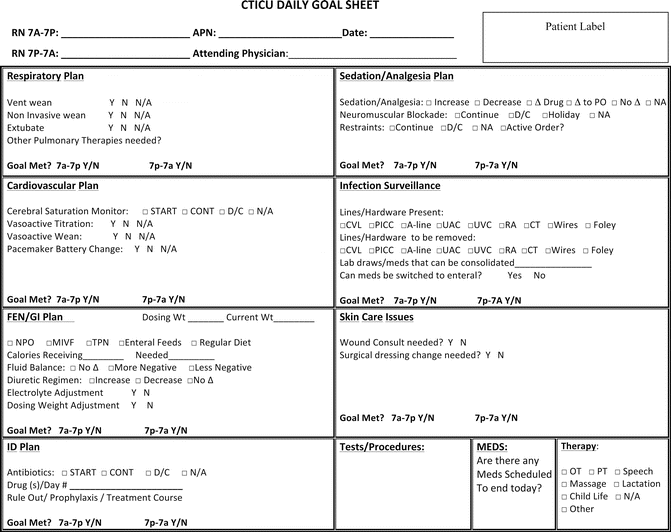Fig. 28.1
Handover template for the operating-room-to-cardiac critical care unit handover
Discharge Handover
The discharge handover is also critical, particularly in the care of neonates with complex congenital heart disease. The National Pediatric Cardiology Quality Improvement Collaborative (NPC-QIC) evaluated the handover that takes place after the Norwood operation between the discharging institution and the outpatient cardiologist and primary care provider. A complete handover was defined as providing the outpatient providers a written list of medications, a nutrition plan, and a list of “red flag” events. The NPC-QIC study found that only 45 % of outpatient cardiologists and 26 % of primary care providers received all three components of the complete handover [8].
The handover from the nursing unit to the parents and primary caregivers is another important component of the discharge process. The parents and caregivers need to learn how to assume the medical care of their child, including administering, for example, multiple medications, complex high-calorie formula feeding regimens, gastric and nasogastric tube feedings, and oxygen. Rooming-in before discharge is one strategy used by many centers to facilitate this handover for complex neonates, especially shunt-dependent and single-ventricle neonates. Parents stay overnight in the hospital for 24 h before their child is discharged. During this time, they are responsible for performing all of the care and therapies, as well as administering all medications themselves.
Home monitoring programs for high-risk and interstage single-ventricle patients are becoming more common, especially after the Children’s Hospital of Wisconsin (Milwaukee, WI) heart center group reported a decrease in the interstage mortality rate after implementing a home monitoring program [7]. These programs consist of several components. Patients need to meet certain minimum nutritional and weight requirements before discharge. Parents are trained before discharge to monitor daily oxygen saturations, patient weight, and volume of enteral intake. They are educated on breeches, such as decreased saturations, poor weight gain, or “red flag” events that require notifying the monitoring team. The team communicates regularly with the family by phone, and all breeches must be evaluated by a member of the team. More recently, the Milwaukee group has reported that their home monitoring program has resulted in normal infant weight gain in their interstage single-ventricle patients [15].
Daily Rounding Communication
Communication during daily rounds is crucial for maintaining quality of care. Daily rounds involve a multidisciplinary team, are performed at the patient’s bedside, and involve the patient’s family, if possible. The optimal make-up of the multidisciplinary team includes the bedside nurse, CICU physician, possibly a cardiology consult physician, pharmacist, dietician, respiratory therapist, patient’s family, and front-line providers (fellows, residents, advance practice nurses, medical students).
Daily goal sheets are increasingly being used in the CICU (Fig. 28.2). The daily goals sheet outlines the tasks to be completed and the care plan for the day. Daily goal sheets have improved physician-nurse communication in pediatric intensive care units and increased the team’s agreement on daily goals [18, 19]. In adult intensive care units, daily goals sheet have reduced ICU length of stay [20, 21]. Modifications to the goal sheet can target areas of team weakness, such as the need to ask, “if the parents wish to join rounds,” or “has the referring physician been updated?” Goal sheets should also require “read backs” on new medications or modifications to medications that include dose, route of administration, and frequency of administration.


Fig. 28.2
Cardiac critical care unit daily rounding goal sheet
Additional strategies to improve the quality of care and reduce errors during daily rounds include limiting interruptions during patient presentations, keeping all members of the team on task, and providing ordered read back of information before moving onto the next patient. Nurse presentations on daily rounds increase the bedside nurse’s engagement on rounds and improve family and staff satisfaction [22, 23]. For example, the bedside nurse presents a brief patient history, notable events over the previous 24 h, current patient status, fluid balance, vital sign trends, review of systems, and recent laboratory and radiologic exam results. The assessment and plan can then be completed by a front-line provider on the CICU team.
Summary
The increasing complexity of congenital heart disease patients and the expanding teams required to care for these patients requires effective communication on all levels. This chapter focused on two of the most complex and challenging handovers (from the OR to the CICU and from the nursing unit to hospital discharge) along with strategies to improve daily rounds. These examples highlight the importance of multidisciplinary collaboration and the value of structured protocols and handover templates. These tools and techniques can be used to improve communication and handover in all aspects of the care of patients with congenital heart disease.
References
1.
< div class='tao-gold-member'>
Only gold members can continue reading. Log In or Register to continue
Stay updated, free articles. Join our Telegram channel

Full access? Get Clinical Tree


